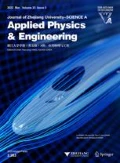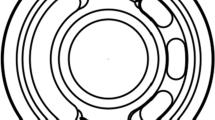Abstract
The 2D principle is a new concept in hydrostatic pump design. It features a piston with a compound motion of both rotation and reciprocation to realize the functions of pumping and distribution. The compound motion is achieved through a specially designed roller-cam rail mechanism. Compared with conventional axial piston pumps, the 2D pump avoids sliding friction pairs completely and optimizes the force balanced conditions in the pump, making it easier to operate at the condition of higher speeds. The pump is also highly integrated for four cycles of suction and delivery for each round of the piston and thus has increased power density. Additionally, by applying a pair of pump units in tandem, the pump eliminates the structural flow ripple, caused by the limited number of pump elements, which exists in traditional pumps. The performance of the proposed 2D pump is highly dependent upon the motion conversion mechanism, especially the roller-cam rail mechanism. A mathematical model of the cam rail is developed and compared with its experimental counterpart to demonstrate its precision. Then, the performance of the piston and the no-load flow characteristics of the tandem pump are tested and analyzed to show the effectiveness of the roller-cam rail mechanism and the viability of the tandem pump. Although the curves of no-load flow characteristic of the tandem pump include a lot of clutter, by analyzing the frequency spectrogram of the curves of flow and revolving speed, they can be smoothed by applying a band-pass filter to remove that clutter. For comparison, the flow ripple in the experimental and simulation results of the tandem pump is smaller than that in simulation results of the traditional piston pump at low pressure. Both the theoretical analysis and experimental results indicate that the surface of the cam rail is precise and the pump has the potential advantage of eliminating sliding friction pairs and flow ripple.
概 要
目 的
由于液压行业对高速重载的要求越来越高, 传统 轴向柱塞泵中存在的润滑与泄漏的矛盾也越发 明显。针对传统轴向柱塞泵中因结构产生的倾斜 力、低功率密度、恶劣的摩擦副工况、较大的流 量脉动等限制, 本文旨在提出一种具有内力平 衡、功率密度高、无纯粹的滑动摩擦副且工况优 秀、能消除结构性流量脉动等优点的二维活塞 泵, 并通过对其工作原理的详细分析, 探讨其具 有上述优点的理论依据。
创新点
1. 提出二维活塞泵; 该泵利用二维运动转换机构 中活塞部件的二维运动, 同时实现了吸排油功能 和配流功能, 提高了集成化; 通过其活塞旋转1 周可以使泵吸排油4 次的结构设计, 提高了功率 密度; 轴向与轴向对称的独特结构布局, 实现了 内力平衡, 消除了传统轴向柱塞泵中无法消除的 倾覆力偶; 相对于传统轴向柱塞泵, 吸排油与配 流功能的集成减少了摩擦副的数量, 且消除了纯 粹的滑动摩擦副, 打破了PV 值的限制, 意味着 二维活塞泵有着实现更大流量压力分布的潜力。 2. 提出二维活塞泵运动转换机构中的锥滚子-凸 轮接触结构, 优化二维活塞泵运动转换机构的受 力条件; 3. 建立二维活塞泵运动转换机构中锥滚 子-凸轮接触副的通用型数学模型, 通过运动学分 析建立精确的凸轮表面模型(即二维活塞泵的运 动学模型), 为二维锥滚轮活塞泵的结构设计和 进一步的静、动力学的研究提供理论基础。4. 消 除结构性流量脉动。
方 法
1. 通过对二维活塞泵结构与工作原理的理论分 析, 讨论其相对于传统轴向柱塞泵所具有的优 点。2. 通过跑合实验, 验证锥滚子-凸轮接触结构 具有的受力条件。3. 通过运动学分析与空间几何 关系变换推导, 得到运动转换机构中具有普遍指 导意义的接触副的通用数学模型。4. 通过实验曲 线与理论曲线的对比, 验证接触副数学模型的正 确性与二维活塞泵所具有的消除结构流量脉动 的潜力。5. 通过滤波处理与模拟仿真, 验证二维 活塞泵能否消除结构性流量脉动。
结 论
1. 二维活塞泵具有功能集成化高、内力平衡、功 率密度高、无纯粹的滑动摩擦副且能消除流量脉 动的优点。2. 运动转换机构中锥滚子-凸轮接触结 构具有更好的受力条件。3. 建立的接触副数学模 型可以指导二维活塞泵中运动转换机构的加工, 且对二维活塞泵进一步的运动学与动力学的研 究具有指导意义。4. 二维活塞泵能消除结构性流 量脉动。
Similar content being viewed by others
References
Cho IS, 2015. A study on the optimum design for the valve plate of a swash plate-type oil hydraulic piston pump. Journal of Mechanical Science and Technology, 29(6): 2409–2413. https://doi.org/10.1007/s12206-015-0533-z
Du RL, Chen YL, Zhou H, et al., 2016. New distributing mechanism for high speed single-piston axial piston pump. Journal of Zhejiang University (Engineering Science), 50(10):1902–1910 (in Chinese). https://doi.org/10.3785/j.issn.1008-973X.2016.10.009
Hong YS, Doh YH, 2004. Analysis on the friction losses of a bent-axis type hydraulic piston pump. KSME International Journal, 18(9):1668–1679. https://doi.org/10.1007/BF02990382
Ivantysynova M, 2008. Innovations in pump design-what are future directions? Proceedings of the 7th JFPS International Symposium on Fluid Power, p.59–64. https://doi.org/10.5739/isfp.2008.59
Luo XH, Niu ZH, Shi ZC, et al., 2011. Analysis and design of an axial piston water-pump with piston valve. Journal of Mechanical Science and Technology, 25(2):371–378. https://doi.org/10.1007/s12206-010-1214-6
Ma JE, Fang YT, Xu B, et al., 2010. Optimization of cross angle based on the pumping dynamics model. Journal of Zhejiang University-SCIENCE A (Applied Physics & Engineering), 11(3):181–190. https://doi.org/10.1631/jzus.A0900417
Manring ND, Zhang YH, 2000. The improved volumetric-efficiency of an axial-piston pump utilizing a trapped-volume design. Journal of Dynamic Systems, Measurement, and Control, 123(3):479–487. https://doi.org/10.1115/1.1389311
Manring ND, Mehta VS, Raab FJ, et al., 2007. The shaft torque of a tandem axial-piston pump. Journal of Dynamic Systems, Measurement, and Control, 129(3):367–371. https://doi.org/10.1115/1.2719785
Manring ND, Mehta VS, Nelson BE, et al., 2013. Increasing the power density for axial-piston swash-plate type hydrostatic machines. Journal of Mechanical Design, 135(7):071002. https://doi.org/10.1115/1.4023924
Manring ND, Mehta VS, Nelson BE, et al., 2014. Scaling the speed limitations for axial-piston swash-plate type hydrostatic machines. Journal of Dynamic Systems, Measurement, and Control, 136(3):031004. https://doi.org/10.1115/1.4026129
Mehta VS, 2006. Torque Ripple Attenuation for an Axial Piston Swash Plate Type Hydrostatic Pump: Noise Consideration. PhD Thesis, University of Missouri-Columbia, Columbia, USA.
Navarro T, 2011. Volumetric Pump with Reciprocated and Rotated Piston. US Patent 7887308.
Ruan J, Burton RT, 2009. An electrohydraulic vibration exciter using a two-dimensional valve. Proceedings of the Institution of Mechanical Engineers, Part I: Journal of Systems and Control Engineering, 223(2):135–147. https://doi.org/10.1243/09596518JSCE634
Ruan J, Burton R, Ukrainetz P, et al., 2001. Two-dimensional pressure control valve. Proceedings of the Institution of Mechanical Engineers, Part C: Journal of Mechanical Engineering Science, 215(9):1031–1038. https://doi.org/10.1177/095440620121500903
Ruan J, Burton R, Ukrainetz P, 2002. An investigation into the characteristics of a two dimensional “2D” flow control valve. Journal of Dynamic Systems, Measurement, and Control, 124(1):214–220. https://doi.org/10.1115/1.1433480
Turner AJ, Ramsay K, Clark RE, et al., 2006. Development of high force electromechanical linear actuator for shift-by-wire automated manual transmissions. SAE 2006 World Congress & Exhibition. https://doi.org/10.4271/2006-01-0360
Vael GEM, van den Brink TL, Paardenkooper T, et al., 2003. Some design aspects of the floating cup hydraulic transformer. Proceedings of the Bath Workshop on Power Transmission and Motion Control, p.35–50.
Xu B, Ye SG, Zhang JH, et al., 2016. Flow ripple reduction of an axial piston pump by a combination of cross-angle and pressure relief grooves: analysis and optimization. Journal of Mechanical Science and Technology, 30(6):2531–2545. https://doi.org/10.1007/s12206-016-0515-9
Zhang JH, Wang D, Xu B, et al., 2018. Experimental and numerical investigation of flow forces in a seat valve using a damping sleeve with orifices. Journal of Zhejiang University-SCIENCE A (Applied Physics & Engineering), 19(6):417–430. https://doi.org/10.1631/jzus.A1700164
Author information
Authors and Affiliations
Corresponding author
Additional information
Project supported by the National Natural Science Foundation of China (No. 51675482)
Rights and permissions
About this article
Cite this article
Jin, Dc., Ruan, J., Li, S. et al. Modelling and validation of a roller-cam rail mechanism used in a 2D piston pump. J. Zhejiang Univ. Sci. A 20, 201–217 (2019). https://doi.org/10.1631/jzus.A1800085
Received:
Accepted:
Published:
Issue Date:
DOI: https://doi.org/10.1631/jzus.A1800085
Key words
- Two-dimensional piston pump
- Functions integration
- Roller-cam rail mechanisms
- Mathematical model
- Zero structural flow ripple




